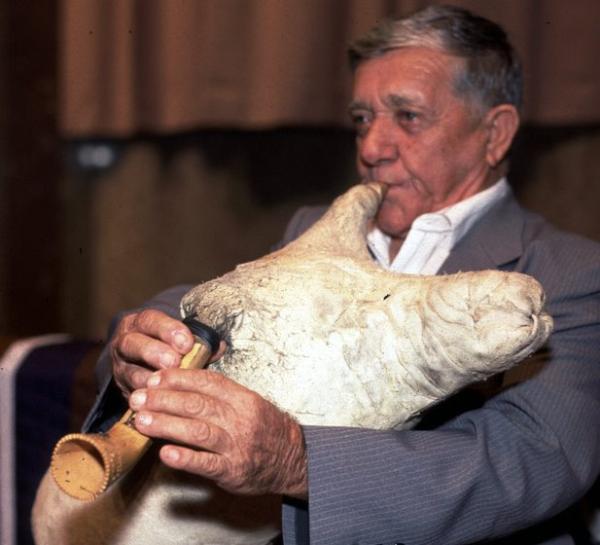Nikitas Tsimouris

Photo ourtesy National Endowment for the Arts
Bio
Nikitas Tsimouris was born in 1927 on Kalymnos, in the Dodecanese, a group of Mediterranean islands belonging to Greece but lying off the Turkish mainland. Like others in the Dodecanese, the Tsimouris family derived its livelihood from both sea and land by fishing, sponge diving, raising small herds of goats and sheep, and farming, cultivating olives, grapes, and other fruits.
As a young man, Tsimouris learned to play the Greek bagpipe, tsabóuna, from his father and other male relatives, who often played the instrument to pass the hours while tending their animals. The tsabóuna is usually made from a goatskin (tragéois), wood, and string. These components are held in place with beeswax and onionskin. The air bag of the instrument (touloumi) is a goatskin turned inside out, with the neck, tail, and two leg openings tied shut. The mouthpiece and chanter (finger pipe) are tightly affixed with string to the remaining two leg openings of the bag. When the bag is filled with air and the air pressure inside is increased by squeezing the bag with the arms, the air forced through the chanter produces sound. Any air leaks are stopped with bits of beeswax, and air is kept from escaping out the mouthpiece by an onionskin flap affixed on the inside with beeswax.
The chanter is traditionally passed from father to son and is inserted in the skin when a new bagpipe is made. Tsimouris's chanter, made of olive wood by his father, has two bamboo reeds. One reed has five finger holes; the other has three. To tune the chanter, he adjusts the reed lengths with a piece of string and reduces the size of certain holes with blobs of beeswax. He plays standing up, wraps his arms around the bag, and keeps pace by tapping his feet. By varying the air pressure in the bag, he is able to "bend" notes or ornament the basic melody with flurries of grace notes. Occasionally, Tsimouris will hold the air pressure with his arms while singing a line or two of a song. The music is essentially designed for dancing, and Tsimouris sometimes paces along with the dancers as he sets the complex seven- and 13-beat rhythms.
In 1968, Tsimouris moved with his family to the tightly knit Greek community of Tarpon Springs, Florida, where he operates a stuccoing business in partnership with his son, Anonios. In Florida, the tsabóuna music he plays is considered antiquated by many, but it continues to serve as a focal point for the needs of cultural preservation. Tsimouris is often invited to perform for weddings and other community events.

